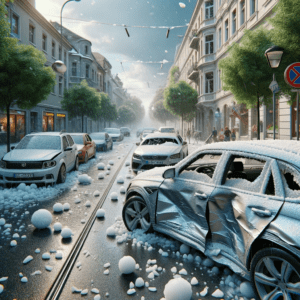How Hail Disrupts the Lives of Cars in Europe
 Europe is witnessing an increasing frequency of hailstorms, leaving visible traces in people’s lives, particularly on their vehicles. Hail is not just a remarkable natural phenomenon but also a serious concern for every motorist. In this article, we will delve into how hail affects cars in Europe, the damages it can inflict, and ways to shield our vehicles from its aftermath.
Europe is witnessing an increasing frequency of hailstorms, leaving visible traces in people’s lives, particularly on their vehicles. Hail is not just a remarkable natural phenomenon but also a serious concern for every motorist. In this article, we will delve into how hail affects cars in Europe, the damages it can inflict, and ways to shield our vehicles from its aftermath.
What is hail, and why does it pose a problem for cars?
Hail is an atmospheric phenomenon characterized by the fall of hard ice pellets known as hailstones. Their size can range from that of a small pea to a golf ball, and in rare cases, they can be even larger. Hail forms within powerful cumulonimbus clouds, driven by strong updrafts of air.
For cars, hail can be a genuine disaster. The ice pellets strike at high velocity, causing dents and scratches on the bodywork. In more extreme cases, hail can even shatter a car’s windows or headlights. According to European statistics, hail damage varies considerably, but in some regions, it is frequent and severe enough to cause concern among motorists.
Typical Car Damage After Hail
The most common damages to cars after a hailstorm include:
- Dents: Hailstones, especially larger ones, can easily leave dents on the roof, hood, and even the side panels of a car.
- Scratches: When hailstones strike at high speed, they can leave marks on the car’s paint.
- Broken Windows and Headlights: Larger and particularly hard hailstones can cause serious damage, such as shattered windows and headlights.
Methods for Repairing Cars After a Hailstorm


- Paintless Dent Repair (PDR): This method is particularly effective for removing dents without the need for repainting. PDR requires great skill and attention to detail, using specialized tools to massage the metal from behind to return it to its original shape.
- Traditional Repair: For more serious damages, such as shattered windows or large dents, a more traditional repair approach may be necessary, including painting and part replacement.
- Paint and Part Replacement: For certain types of damage, especially when deep scratches or broken parts are present, repainting or replacing damaged parts may be necessary.
- DIY Repair: For car owners who prefer to handle the repair themselves, there are numerous guides and video tutorials available to assist in the process.
The choice of repair method depends on the extent of the damage and the car owner’s preferences.
Insurance and Hail Damage Coverage
Regarding insurance, it is important for car owners to understand precisely what their policy covers in the event of hail damage. In many European countries, auto insurance policies include coverage for damages caused by natural disasters, including hail. It is essential to contact your insurer for details on coverage and claims procedures. Insurance Claim Process: The insurance claim process may vary depending on the company and policy but generally involves documenting the damages and assessment by the insurer.
Preventing Hail Damage to Cars
To minimize the risk of hail damage, it is important to take certain measures:
- Indoor Parking: Whenever possible, park your car in a garage or under some form of cover.
- Use Specialized Covers: There are specialized car covers available that can protect against hailstones.
- Monitor Weather Conditions: Stay informed about weather conditions, especially if you live in an area known for frequent hailstorms.
- Education and Awareness: Stay updated with the latest methods and products for hail protection. Participating in automotive forums and reading specialized blogs can be extremely helpful.
- Expert Advice: It is always wise to seek advice from professionals in the automotive industry, especially if you live in an area with frequent hailstorms.
Conclusion
Hail can be extremely destructive to cars, but with the right preparation and knowledge, damage can be minimized or completely avoided. It is crucial for motorists to be informed not only about repair methods but also about ways to protect their cars from this natural element.
Furthermore, it is important to mentally and financially prepare for the possibility of hail-related damage to our vehicles. Adequate preparation may include creating a special fund for unexpected car repairs or even considering purchasing insurance that covers such damages.
Useful Resources
For more information and resources, the following links and sources may be helpful:
- Weather websites and apps: For up-to-date weather information and hail alerts.
- Auto insurance websites: For details on insurance policies and hail damage coverage.
- Automotive forums and blogs: For advice and recommendations from other drivers regarding car protection and repair after a hailstorm.
- Technical documentation: It is also recommended to familiarize yourself with your vehicle’s technical specifications and manuals, as they can provide valuable information on maintenance and repair after hail damage.
In conclusion, hail can pose a challenge for any motorist, but with proper preparation and information, you can reduce the risk of serious damage to your car. Whether you choose the right repair or prevention method, being informed and prepared is essential.



